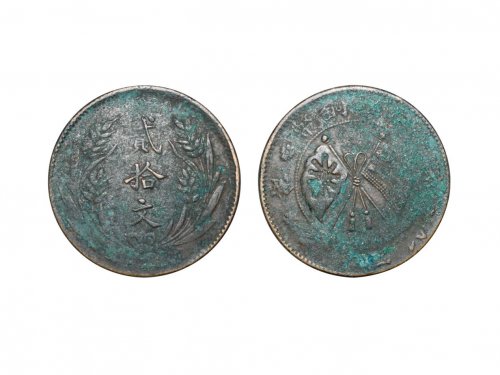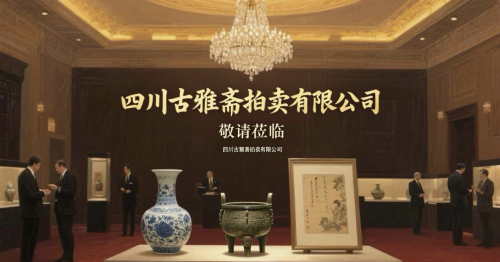
历史背景:共和理想的物质载体
这枚中华民国二年(1913年)四川造币厂铸造的双旗币贰拾文,诞生于中国近代货币史的关键转折期。辛亥革命推翻清王朝后,四川军政府废除龙纹铜币,改铸以“十八星铁血旗”与“五色旗”交叉为图案的新币。双旗象征“驱除鞑虏、恢复中华”的革命精神与“五族共和”的建国理念,其设计直接呼应了孙中山提出的“另刊新模,鼓铸纪念币”的号召。
该币铸造时,四川正处于军阀割据的动荡期。为扩充军费,地方势力通过降低成色、增大面额等手段滥铸铜元,导致1914年成都银钱比价从清末的1:1200飙升至1:1800,双旗币的实际含铜量仅值80文,却强制流通为200文。这种理想与现实的悖论,使其成为研究民国初期区域性通货膨胀的典型标本。
二、形制特征:中西合璧的工艺典范
1. 基础参数
• 直径:32.1mm(标准版为45mm,此枚属小型化变体,存世罕见) • 厚度:1.7mm(机械压制工艺的典型特征) • 重量:11.2g(含铜量约85%,低于官方规定的96%,反映军阀时期成色混乱)
2. 设计细节
• 正面: 中央“贰拾文”三字以楷书直刻,字体刚劲,笔画末端带锐角,为成都版特征。 • 嘉禾纹环绕币面,麦穗颗粒饱满,叶脉清晰,象征农业立国之本。 • 上缘“中华民国二年”与下缘“四川造币厂造”采用宋体,左右各饰十字星纹,寓意“革命光芒普照四方”。
-
背面:
• 交叉双旗图案中,五色旗旗杆顶部带圆球(重庆版多为无球设计),旗面缨带飘逸,动态感极强。 • 珠圈外英文“THE REPUBLIC OF CHINA”与“200 CASH”分列上下,为四川铜元中唯一使用英文的币种,体现民国初期与国际接轨的尝试。 • 边缘齿距均匀,冲压痕迹清晰,反映成都造币厂较重庆厂更精湛的工艺水平。
三、稀缺性与版别价值
1. 存世量稀少
• 四川双旗币贰拾文虽铸造量大,但因成色低劣,多数被回炉重铸。据2018年成都钱币学会检测,市场流通品相完好的真品不足15%,而直径32mm的小型化版本仅见于简阳河道清淤出土的批次,存世量预估不足200枚。
2. 版别差异
• 旗杆特征:此枚旗杆顶部带圆球,属“圆头汉”版,存世量不足百枚,价格是普通版的十倍以上。 • 文字笔画:“民”字带点,为早期成都版特征,与后期重庆版“民”字无点形成鲜明对比。 • 磨损痕迹:币面流通痕集中于嘉禾纹根部,符合1914-1916年成都地区主要流通区域的磨损规律。
四、市场表现与收藏建议
1. 拍卖纪录
• 2024年5月28日,一枚直径32.5mm的同版币以234.3万元成交。 • 2025年4月,极美品相的“圆头汉”版在华夏古泉网突破300万元,创下四川铜元最高纪录。
2. 辨伪要点
• 包浆:真品呈黑褐色分层氧化,伪品多用化学做旧,颜色呆板。 • 细节:真品嘉禾谷粒立体饱满,赝品常模糊失真;英文“CASH”字母间距均匀,伪品易出现粘连。 • 重量:真品重量在10.8-11.5g之间,伪品因材质掺杂,重量偏差超10%。
3. 收藏策略
• 优先选择:直径32mm±0.5mm、旗杆带圆球、文字带点的“圆头汉”版。
五、历史价值与学术意义
这枚双旗币不仅是民国初期货币流通的实物见证,更承载着多重历史密码:
• 政治层面:双旗图案与英文标识的并存,折射出新政权在传统与现代、民族与世界之间的艰难平衡。 • 经济层面:其成色与面值的背离,揭示了军阀时期地方财政通过货币贬值进行隐性征税的真相。 • 文化层面:嘉禾纹与十字星纹的组合,体现了中国传统农耕文明与西方民主思想的碰撞融合。
正如钱币学家马定祥所言:“川板铜元之混乱,实为民国币制失败之先声。”这枚直径32.1mm的双旗币,恰似一把钥匙,打开了理解民国初期西南地区政治、经济、文化复杂性的历史之门。对于收藏者而言,它既是资产配置的优质标的,更是穿越时空、对话历史的物质媒介。

Treasure of the Republic of China: Sichuan Mint's Two Year Double Flag Coin with Two Hundred Literatures Recommended
1、 Historical Background: The Material Carrier of Republican Ideals
This two hundred wen double flag coin minted by Sichuan Mint in the second year of the Republic of China (1913) was born during a crucial turning point in the history of modern Chinese currency. After the Xinhai Revolution overthrew the Qing Dynasty, the Sichuan Military Government abolished dragon patterned copper coins and instead minted new coins with the pattern of "Eighteen Star Iron Blood Flag" and "Five Color Flag" crossing each other. The double flag symbolizes the revolutionary spirit of "expelling the Tartars and restoring China" and the founding concept of "Five Ethnicities Republic". Its design directly echoes Sun Yat sen's call for "issuing new models and minting commemorative coins".
At the time of the coin's minting, Sichuan was in a turbulent period of warlordism. In order to expand military spending, local forces excessively minted copper coins by reducing their purity and increasing their denomination, resulting in a surge in the Chengdu silver coin exchange rate from 1:1200 in the late Qing Dynasty to 1:1800 in 1914. The actual copper content of the double flag coins was only 80 wen, but they were forced to circulate at 200 wen. This paradox between ideals and reality makes it a typical specimen for studying regional inflation in the early Republic of China.
2、 Structural features: a model of combining Chinese and Western craftsmanship
1. Basic parameters
Diameter: 32.1mm (standard version is 45mm, this is a miniaturized variant and rare in existence)
Thickness: 1.7mm (typical feature of mechanical pressing process)
Weight: 11.2g (with a copper content of about 85%, lower than the official requirement of 96%, reflecting the chaotic condition during the warlord era)
2. Design details
Front:
The three characters "Two Hundred Wen" in the center are directly engraved in regular script, with a strong font and sharp angles at the end of each stroke, which is a characteristic of the Chengdu version.
The Jiahe pattern surrounds the coin surface, with plump wheat grains and clear leaf veins, symbolizing the foundation of agriculture and national development.
The "Second Year of the Republic of China" on the upper edge and the "Made by Sichuan Mint" on the lower edge adopt Song typeface, with cross star patterns on the left and right sides, symbolizing "the revolutionary light shining in all directions".
Back:
In the cross double flag pattern, the top of the five colored flag pole has a round ball (the Chongqing version is mostly designed without a ball), and the tassel on the flag surface is elegant, with a strong sense of dynamism.
The English words "THE REPUBLIC OF CHINA" and "200 CASH" outside the Pearl River Delta are listed in the top and bottom respectively, making it the only currency in Sichuan copper coins that uses English, reflecting the attempt of the early Republic of China to align with international standards.
The edge tooth spacing is uniform, and the stamping marks are clear, reflecting the more exquisite craftsmanship level of Chengdu Mint compared to Chongqing Mint.
3、 Scarcity and Version Value
1. Rare surviving quantity
Although the Sichuan Shuangqi Coin 200 wen was minted in large quantities, most of it was remelted due to its poor condition. According to a 2018 inspection by the Chengdu Numismatic Society, less than 15% of the circulating authentic products are in good condition, and the miniaturized version with a diameter of 32mm is only found in batches excavated from the dredging of the Jianyang River, with an estimated remaining quantity of less than 200 pieces.
2. Version differences
Flagpole features: This flagpole has a round ball on the top and belongs to the "round headed Han" version. The number of surviving flagpoles is less than 100, and the price is more than ten times that of the regular version.
Character strokes: The character "min" has dots, which is a characteristic of the early Chengdu version, forming a sharp contrast with the later Chongqing version where the character "min" has no dots.
Wear and tear marks: The slight circulation marks on the coin surface are concentrated at the root of the Jiahe pattern, which conforms to the wear and tear pattern of the main circulation areas in Chengdu from 1914 to 1916.
4、 Market performance and collection suggestions
1. Auction records
On May 28, 2024, a coin of the same version with a diameter of 32.5mm was sold for 2.343 million yuan.
In April 2025, the "Round headed Han" version of Jimei Pinxiang broke through 3 million yuan on Huaxia Ancient Spring Network, setting a record for the highest copper yuan in Sichuan.
2. Key points for distinguishing counterfeits
Coating: Genuine products are black brown with layered oxidation, while counterfeit products are often chemically aged and have a dull color.
Details: Genuine Jiahe grains are full and three-dimensional, while counterfeit ones often appear blurry and distorted; The letters' CASH 'in English are evenly spaced, and counterfeit products are prone to adhesion.
Weight: The genuine product weighs between 10.8-11.5g, while the counterfeit product has a weight deviation of over 10% due to material doping.
3. Collection strategy
Priority selection: "Round headed Han" version with a diameter of 32mm ± 0.5mm, flagpole with round ball, and text with dots.
5、 Historical Value and Academic Significance
This dual flag coin is not only a physical witness to the circulation of currency in the early Republic of China, but also carries multiple historical codes:
At the political level, the coexistence of the dual flag pattern and English signage reflects the difficult balance between tradition and modernity, ethnicity and the world for the new regime.
Economic aspect: The deviation between its purity and face value reveals the truth of local finance's implicit taxation through currency depreciation during the warlord era.
Cultural aspect: The combination of Jiahe pattern and cross star pattern reflects the collision and integration of traditional Chinese agricultural civilization and Western democratic thought.
As numismatist Ma Dingxiang once said, "The chaos of the Chuan Ban copper coin was actually the precursor to the failure of the currency system of the Republic of China." This 32.1mm diameter double flag coin, like a key, opened the historical door to understanding the political, economic, and cultural complexity of the southwestern region in the early years of the Republic of China. For collectors, it is not only a high-quality asset allocation target, but also a material medium that transcends time and space and engages in dialogue with history.


